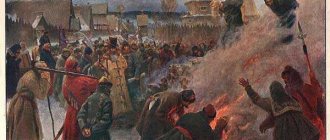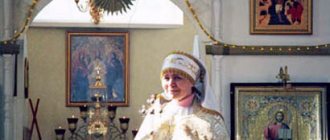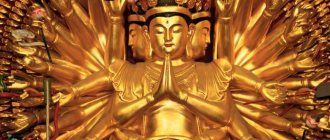Chinese Orthodox Church
, an autonomous Church within the Moscow Patriarchate
- On the map: Yandex.Map, Google map (no exact coordinates)
Numbers about 15 thousand believers:
- About 7 thousand descendants of the Three Rivers Cossacks living compactly in the area of the city of Labdarin in the province of Inner Mongolia in the so-called. Russian Autonomous District.
- About 3 thousand ethnic Russians and Chinese are from mixed marriages in the Xinjiang Uyghur Autonomous Region (Urumqi, etc.).
- Several hundred Orthodox Chinese descendants of the Albazin Cossacks, captured at the end of the 17th century after the defeat of the city of Albazin in the Amur region by the Manchus, live mainly in Beijing and dispersedly in other provinces of China.
- A small number of Orthodox Chinese are descendants of those converted to Orthodoxy by the Russian Spiritual Mission in the 18th - early 18th century. centuries
Due to the complex historical destinies and the position of modern Chinese authorities, the activities of the Church are strictly limited. Religious legislation of the PRC does not allow unofficial services; you can only pray in the homes of parishioners. The operating legally registered churches of the Chinese Orthodox Church are Ininsky Nikolsky, Labudalinsky Innokentievsky, Urumchi Nikolsky and Harbin Pokrovsky. In addition to them, there are also a number of parishes and communities for foreigners who are not officially part of the Chinese Church in China.
The last Chinese priest of the old order who served in China until the end of his days, Archpriest Alexander Du, died in 2003; Father Mikhail Van, who lived until 2015, could not perform regular services. Archpriest Michael Lee, who served in the clergy of the Russian Orthodox Church Outside of Russia in Australia, died in 2021. At the same time, in 2014, for the first time in 60 years, new Chinese clergy were ordained to serve in China - priest Anatoly Kun and deacon Alexander Yu. In 2018, priest Pavel Sun was added to them.
There are no bishops. Until the Local Council of the Chinese Autonomous Orthodox Church elects its Primate, the canonical care of parishes in the territory of the People's Republic of China is carried out by the Patriarch of Moscow and All Rus'.
History of the Chinese Church
Christianity in China until the 17th century.
Historical sources that have reached us indicate that Christianity was practiced in centuries and later by many peoples inhabiting Western China. With the beginning of the persecution of Christians in the Chinese Empire and with the establishment of Islam in Western China, Christianity seemed to have finally left the country.
Orthodox Russian people first appeared within what is now China in the 13th century, when, after the Mongols burned Kyiv, several tens of thousands of prisoners were taken to the depths of Asia. But by the middle of the next century, having no connection with their homeland and spiritual support, they were completely assimilated and dissolved into the local tribes. However, even today one can still find ancient traces of Christianity in China dating back to different periods of the country’s history.
Orthodoxy in China from the 17th century to 1917
The history of Orthodoxy in China begins with the arrival of Elder Hermogenes in the fortress of Albazin, who in 1671, with the consent of all Albazinians, founded a monastery near the fortress in the name of the All-Merciful Savior, and through his efforts the Church of the Resurrection of Christ was built in the fortress. In 1685 Albazin was taken and devastated by the Chinese. After the final loss of Albazin in 1689, some Albazins settled in Beijing.
In 1713, the Russian Spiritual Mission in China was established, the tasks of which were initially, in addition to the pastoral care of the Orthodox in Beijing, scientific activity and the implementation of diplomatic functions. After the signing of the Tianjin Treaty in 1864, which granted religious freedoms to foreigners, the activities of Russian missionaries began to actively develop.
In the 18th century, the Russian Orthodox Church established an episcopal see in China. The idea of the need to send a bishop with the Mission was expressed by Metropolitan Philotheus, who was then again in charge of the Siberian diocese after the death of Metropolitan John (Maksimovich). Having received the news of the death of Fr. Hilarion, he wrote to Prince Gagarin:
“We thank God that the Christian faith is expanding, the name of God is glorified among the nations, and henceforth there is hope for the glorification of the name of God among the Chinese... If your Excellency receives zeal for God, having advised the Right Reverend Stefan (Yavorsky), report him to the Royal Majesty and, having elected You will send a kind and wise man there to the kingdom of China without delay. Even if you honor him with the rank of bishop and send 15 people to the clergy with him, because they Chinese understand that His Royal Majesty will send such people to strengthen eternal peace.”
The saint's thought was received with sympathy by members of the Governing Senate and the Holy Synod. The first Orthodox bishop in China was St. Innokenty (Kulchitsky), however, he was unable to arrive in China.
Orthodoxy was not the only Christian denomination in the Middle Kingdom. At that time, in the capital of the Chinese Empire there were many Jesuits, who appeared in China at the beginning of the 16th century, and after them, in 1631, Dominicans and Franciscans arrived from Italy, France, and Portugal. Louis XIV assigned twenty French missionaries a boarding house of 9,200 livres; the papal emissaries also received subsidies from the Chinese Bogdykhan, for which, among other works, they compiled a geographical atlas of the Chinese Empire from 1708 to 1718. By 1723, there were over 300,000 Catholic proselytes in China, who by the 18th century translated up to 500 books of religious and moral content into Chinese, including the Old and New Testaments. Representatives of various Catholic congregations obtained plots of land in Beijing and, by 1721, erected four churches on them. One of them, the northern one, was even located in the “red city”, near the palace. The Jesuits received this place from Kangxi in gratitude for curing him of a dangerous fever. The Jesuit Verbier, being almost constantly with the emperor during his childhood, exhausted all his eloquence to convert Kangxi, who showed great respect for the “religion of the Lord of Heaven,” did not even forbid his subjects to accept it, but he himself remained and died in paganism. However, despite such an advantageous position, at this time there were strong strife among Catholic missionaries due to the Jesuits’ relaxation of Chinese customs. These divisions undermined the strength and importance of Catholics in Beijing. Shortly before the appointment of Fr. Innocent (Kulchitsky), the papal legate Mezzabarba visited the capital of China with a failed mission on controversial issues. It was under such conditions that the Russian Orthodox Mission continued its preaching.
By 1860, there were no more than 200 Orthodox Christians in China, both Chinese and Manchus, and descendants of Russian “Albazins”.
The second half of the 19th century marks the initial period of the spread of Orthodoxy in China beyond the capital of the Empire. The Russian Spiritual Mission in Beijing in 1864 was relieved of its duties of performing diplomatic functions in connection with the opening of the Russian Embassy. Members of the Mission, scientists and theologians, began work on translating liturgical literature into Chinese. This period of the Mission’s activity is also famous for the Sinological works of its members, which laid the foundation for Russian Sinology. The beginning of the century was a brief period of heyday for the Beijing Mission. Over the course of several decades, many translations of the Holy Scriptures into Chinese were made, the main liturgical texts and some works of the holy fathers were translated. In those years, the Mission published both scientific works of members of the Beijing Mission and church books. The first Chinese monastery was founded in Beijing. Metochions of the Beijing Mission operated in Moscow and St. Petersburg.
During the existence of the Russian Spiritual Mission in China, thirty-seven churches were built (including churches in Beijing, Harbin, Tianjin, Shanghai, which were distinguished by their originality), more than forty preaching points were created, five dioceses (Beijing, Tianjin, Xinjiang, Shanghai, Harbin ); An Orthodox seminary, twenty male and female religious schools were established, religious teaching was disseminated, a library was opened, a publishing house was founded and the magazine “Chinese Evangelist” (“Zhongguo fuyn bao”) was published in Russian, English and Chinese, and charitable activities were carried out.
As a result, the so-called “Boxer uprising” (1899-1901) out of 1000 people of the Orthodox flock, the Russian Spiritual Mission lost 300 people; some of them renounced Orthodoxy, but others, including 222, became holy confessors and martyrs for the faith of Christ.
In 1902, a decision was made to elevate the Head of the Russian Ecclesiastical Mission in China, Archimandrite Innokenty (Figurovsky), to the rank of bishop, whose responsibilities included archpastoral care of the Orthodox flock living throughout China, Mongolia, Xinjiang and Tibet. In the same year, the Holy Synod decided to canonize 222 Chinese martyrs who suffered from the Yihetuan.
Orthodoxy in China from 1917 to the 1980s
The period after 1917 became complex and at the same time fruitful. The exile of the Russian emigration of half a million in China yielded abundant fruits of holiness: the miracle workers of modern times - St. Jonah of Hankow and Archbishop John of Shanghai, pious archpastors, inhabitants of the Harbin monasteries, who acquired the grace-filled gifts of clairvoyance, many secret ascetics of piety, whose names only God knows. The relatives of the last Emperor Nicholas II, killed in Alapaevsk in 1918, found their final refuge and rest in China. In Beijing, before moving to Jerusalem, the Venerable Martyrs Elisaveta Feodorovna and the nun Varvara (Yakovleva) rested their holy relics.
The tragic revolutionary events in Russia and mass emigration from Russia to China interrupted the missionary activities of the Russian Orthodox Church in China. The clergy of the Beijing Mission almost did not preach Orthodoxy among the Chinese, but concentrated all their work on pastoral care for Russian refugees.
Since 1918, the Russian Spiritual Mission in China was cut off from any ties with the Motherland and was subsequently subordinated to the Synod of Bishops of the Russian Orthodox Church Outside of Russia.
In the 20s - 40s of the last century, China became more familiar with Orthodoxy - Russian emigrants built more than a hundred churches in China - in Beijing, Harbin, Xinjiang, Inner Mongolia, Hong Kong, Hankou, Tianjin - in all the cities where Russians lived , one could see Orthodox churches. Orthodoxy was perceived, however, as a “Russian faith” - China’s acquaintance with the Church was external. Services in Chinese were held only in Beijing, and even then infrequently. The Chinese flock of the Russian Orthodox Church were mainly peasants. By 1949, up to 106 Orthodox churches had been built in China: both in the North and South of the country, in the largest cities and provinces.
On December 27, 1945, by decree of the Holy Synod of the Russian Orthodox Church, the Far Eastern dioceses in China became part of the Moscow Patriarchate in accordance with requests for reunification with the Mother Church of Metropolitan Meletius of Harbin and the Head of the Mission, Archbishop Victor of Beijing, with their vicars.
In June 1946, the East Asian Exarchate of the Moscow Patriarchate was formed on Chinese territory, which included the Harbin and Beijing dioceses.
The Chinese revolution of 1949 and the subsequent mass emigration of Russian refugees from China raised the question of the creation of the Chinese Autonomous Orthodox Church before the Church. After the “exodus” of Russian believers from China in 1949, 10,000 Orthodox Christians remained in the country.
The new communist government increased pressure on the Church - a policy of state atheism was proclaimed in China. The Russian Orthodox Church was forced to leave China, leaving its half-daughter, the Chinese Church, in the face of the terrible events of the “great proletarian cultural revolution,” known for the barbaric outrages of the Red Guards, the destruction of churches and cemeteries, the desecration of relics and the burning of icons. For several decades, the Church in China seemed to cease to exist - churches were destroyed, services were not held for more than 20 years.
In 1954, the Russian Spiritual Mission in China was closed. On April 24, 1956, the head of the Department of Cults under the State Council of the People's Republic of China, He Chenxiang, gave his consent to the appointment of Archimandrite Basil (Shuang) as Bishop of Beijing, who was also supposed to temporarily serve as head of the Chinese Orthodox Church. The Department of Cults expressed an opinion on the desirability of preserving the Orthodox center of the PRC in Beijing. It was promised to build a new temple and living quarters for clergy and Orthodox Christians. The Department of Cults under the State Council of the People's Republic of China was notified of the opinion of the Moscow Patriarchate on the organization of governance of the Orthodox Church in the People's Republic of China. On November 23, 1956, the Holy Synod of the Russian Orthodox Church decided to grant autonomy to the Chinese Orthodox Church and consecrate Archimandrite Vasily (Shuang) as Bishop of Beijing, which took place on May 30, 1957 in Moscow.
After the death of Chinese citizens, Bishops Basil of Beijing (1962) and Shanghai Simeon (1965), the Chinese Orthodox Church lost its archpastoral leadership.
The “Cultural Revolution” of 1966-1976 destroyed the institutionally young Chinese Autonomous Orthodox Church. All Orthodox churches were closed, many priests suffered persecution, exile, and some were killed.
The current state of Orthodox life in China
Orthodoxy in China began to revive in the mid-80s. The first church to open was the Holy Protection Church in Harbin. The few Russians and Orthodox Chinese remaining in Harbin received permission to pray there in 1986. Priest Gregory Zhu, who served in Harbin until his death in 2000, was appointed rector of the temple. Today there are about 120 parishioners in the Harbin parish, only 7 of them are Russian. Divine services were performed in Slavic - Chinese liturgical books confiscated during the years of the “cultural revolution” have not yet been returned. During the service in the Harbin Church, the name of His Holiness Patriarch of Moscow and All Rus' Alexy II was exalted.
In September 1997, the restoration of the St. Sophia Church, which was once the decoration of Harbin, was completed.
On the territory of the Autonomous Region of Inner Mongolia, in Trekhreche, about 7,000 Orthodox Christians live, mostly Russian descendants of the Trekhreche Cossacks. The center of their church life is the city of Labdarin. On one of the main streets of this city, as if in compensation for the 18 destroyed churches of the Three Rivers, the authorities erected a new church in honor of St. Innocent of Irkutsk, consecrated in 2009. However, due to the absence of a priest, regular services were not held there.
In Urumqi in 1986, a community of three thousand Russians living in Xinjiang obtained permission to build the St. Nicholas Church. Construction was completed by 1990. Services in the temple, however, did not resume - there are also no priests in Xinjiang. The temple remained unconsecrated to this day. On holidays and Sundays, Orthodox Christians in Xinjiang themselves gather in church for prayer. The authorities of the Xinjiang Uyghur Autonomous Region of the People's Republic of China declared Christmas a non-working day for the Orthodox population. On Easter days, local authorities organize a festive banquet for Orthodox Christians. In Xinjiang, Orthodox churches were also built in Ghulja (Yining) and Chuguchak.
In 1993, a delegation of the Russian Orthodox Church headed by Metropolitan Kirill of Smolensk and Kaliningrad, Chairman of the Department of External Church Relations, visited China. A Chinese delegation led by Priest Gregory Zhu paid a return visit to Moscow.
Since the granting of Autonomy to the Chinese Orthodox Church, the name of the Primate of the Mother Church, the Patriarch of Moscow and All Rus', has been strictly exalted during divine services in all parishes of the Chinese Autonomous Orthodox Church.
The now deceased rector of the parish in Harbin, priest Gregory Zhu, received the Holy Chrism and a new antimension from the Moscow Patriarchate in 1996.
In Beijing, around the territory of the Russian Embassy - the former territory of the Russian Spiritual Mission - about 400 Albazinians live to this day. All of them retained the faith and were able to secretly baptize their children and grandchildren during the years of the Cultural Revolution. An elderly Chinese priest, Archpriest Alexander Du, also lived in Beijing until his death in 2003. Despite his advanced age, he repeatedly appealed to the Beijing city authorities with a request to open a temple for Orthodox Beijingers, but was always refused.
About 30 Orthodox Chinese live in Shanghai. Just like in Beijing, the authorities have not agreed to this day to open an Orthodox church in Shanghai. The city authorities of Shanghai declared architectural monuments and took under their protection two surviving Orthodox churches in the city - the Cathedral in memory of the Icon of the Mother of God “Support of Sinners” and St. Nicholas Church, erected in memory of the assassination of Emperor Nicholas II. The bishop's house has been preserved next to the cathedral. There is a stock exchange in the cathedral itself, and a restaurant in the St. Nicholas Church.
On February 17, 1997, the Holy Synod of the Russian Orthodox Church decided, in connection with the 40th anniversary of the granting of autonomy to the Chinese Orthodox Church in 1997, to more fully provide care for the flock of the Chinese Autonomous Orthodox Church. It was also decided that until the Local Council of the Chinese Autonomous Orthodox Church elects its Primate, the canonical care of parishes in the territory of the PRC is carried out by the Patriarch of Moscow and All Rus'.
The Chinese Autonomous Orthodox Church continued to experience oppression and pressure from the authorities for a long time. For years it was impossible to resolve the issue of ordaining new clergy, there was no opportunity to publish the Holy Scriptures and liturgical books, or to receive church education. The last Chinese priest of the old order in the clergy of the Chinese Church, Priest Michael Wang, died in 2015. At the same time, in the 2010s, progress was made for the better: in 2014, for the first time in 60 years, two new Chinese clergy who were educated in theological schools of Russia were ordained - priest Anatoly Kun and deacon Alexander Yu; in 2021, priest Pavel Sun was added to them. The publication of new liturgical and catechetical texts in Chinese began.
The Patriarchate of Constantinople established the Metropolitanate of Hong Kong and Southeast Asia in 1996. In 2008, the Holy Synod of the Patriarchate of Constantinople redefined the boundaries of the Metropolitanate of Hong Kong, including within its boundaries the People's Republic of China, Taiwan and a number of Southeast Asian states. The Council of Bishops of the Russian Orthodox Church in 2008 declared the inviolability of the canonical borders of the Chinese Autonomous Orthodox Church and approved the position on protecting the rights of the flock of the Chinese Orthodox Church, formulated in the corresponding statement of the Holy Synod of April 15, 2008 [1].
Current situation
To the beginning 21st century in China there were several. thousands of believers belonging to the CAOC, living in Beijing, Shanghai, Prov. Heilongjiang Autonomous Regions (Xinjiang Uygur and Inner Mongolia). The Church has no leader. Kanonich. care for her flock is carried out by the Patriarch of Moscow and All Rus'. Chairman of the Department for External Church Relations Moscow. Patriarchy is entrusted with practical decisions. issues related to the regulation of Orthodox life in China. The department has resumed publication of the journal. “Chinese evangelist” in Russian. language, with some materials in Chinese. language; by China's forces. believers with the support of the Tashkent and Central Asian Diocese of the Russian Orthodox Church in China. language published by "Chinese Evangelism". Divine services are performed in Chinese, Church Slavonic and English. languages. By the decision of the Holy Synod of October 6, 2008, the activities of the parish in honor of the Holy Apostles Peter and Paul were resumed in a special administration. area of the PRC Hong Kong (Hong Kong).
Church of the Intercession of the Blessed Virgin Mary (Harbin)[edit]
The Ukrainian parish with a church in honor of the Intercession of the Most Holy Theotokos was founded in Harbin in 1922 with the blessing of Metropolitan Methodius (Gerasimov) of Harbin and Manchuria and until 1930 it was located in the building of the Ukrainian House in Harbin. After the house was removed from the jurisdiction of the Ukrainian community, the parish rented basement space on Bolshoy Prospekt for some time.
In 1930, the land administration allocated a plot to the community at the Old Harbin Cemetery, where the burials of Russian soldiers were located. The temple was founded on June 1, 1930 and built in the Byzantine style according to the design of civil engineer Yu. P. Zhdanov with funds from the parish and Russian residents of Harbin. On December 14, 1930, the temple was consecrated by Metropolitan Methodius in honor of the Intercession of the Most Holy Theotokos.
The cost of construction was 32 thousand yen, most of which the parish received as a loan.
The church was closed during the Cultural Revolution. During the thaw, it was restored and opened for worship.
Address:
China, Harbin, 266, Dongdazhi, Nangan district
Directions:
Bus 13 to the Yi DA Yi Yuan stop (for reference, there are Orthodox, Catholic and Protestant churches on the same spot)
Temple of the Holy Apostles Peter and Paul (Hong Kong)[edit]
On July 10, 1934, by decree of the head of the Russian spiritual mission in China, Bishop Victor (Svyatin) of Beijing, the Peter and Paul Parish in Hong Kong, which at that time was a British colony, was formed, and the Hong Kong deanery was formed, which also included churches in Guangzhou, Macau and Manila. Archpriest Dmitry Uspensky was appointed rector here. The core of its parishioners were emigrants from Russia who worked in English companies and had British citizenship.
Prior to the opening of a permanent house of worship on Middle Road, 8 services were held in an Anglican church. In addition to the temple itself, the Orthodox community in Hong Kong included a Ladies' Circle dedicated to church splendor and education, a Charitable Foundation, a Church Construction Fund and an amateur choir.
Address
: 12 FL., Kingdom Power Commercial Building, 32-36 Des Voeux Rd W, Sheung Wan
Telephone:
+852 3585 8767;
Email:
Assumption Church (Harbin)[edit]
It was built partly with donations from Russian Harbin residents, and partly with funds from the Chinese Eastern Railway and the Harbin St. Nicholas Cathedral. The author of this Russian-style temple was civil engineer N.A. Kazy-Girey, one of the participants in the construction of the Chinese Eastern Railway and the city of Harbin. The consecration was performed on November 22, 1908 by Archbishop of Vladivostok and Primorsky Eusebius (Nikolsky), who arrived from Vladivostok, according to whom, this temple, created in a foreign land and overshadowing the graves of Russian Orthodox people who died far from their homeland, should have special significance for the residents of Harbin.
In 1966, during the “Cultural Revolution”, the Chinese Red Guards completely destroyed the Assumption Cemetery with bulldozers and turned it into a park, and tombstone marble and granite slabs were used to line the embankment of the Sungari River; many slabs were laid with inscriptions up and passers-by walked on them. The domes with crosses were removed from the Assumption Church, and the premises were used as a laughter room.
The church building, which has lost its dome, is today used as an exhibition building. As of March 2021, negotiations were underway to make this temple operational.
Address:
China, Heilongjiang, Harbin
Church of the Assumption of the Blessed Virgin Mary (Beijing)[edit]
On August 15, 1732, the first Assumption Church was consecrated in Beijing as part of the Russian Ecclesiastical Mission in Beijing, built in a place of compact residence of the descendants of captured Russian Albazin Cossacks. It was destroyed in June 1900 during the Yihetuan uprising.
The reviving Russian spiritual mission began the construction of the Church of All Holy Martyrs, the church in the name of Seraphim of Sarov at the Russian cemetery in the Andingmen area (now Qingnianhu Park), and the gate bell tower of the Mission; for the cross bishop's church in the name of St. Innocent of Irkutsk, the Red Fanza was re-laid. But since the construction of these structures took time, they decided to build a temporary Assumption Church, as a result of which it was distinguished by laconic composition, simplicity of articulations, simplicity of forms and details, and the absence of elaborate decoration.
Address:
People's Republic of China 100600 Beijing, st. Dongzhimen Beizhongjie, 4.
Telephone
: + (86) 135 526 403 94 or + (86) 135 526 430 74
Website
: www.orthodoxbj.com
Content
- 1 Cathedral of the Icon of the Mother of God “Helper of Sinners” (Shanghai)
- 2 Temple of the Assumption of the Blessed Virgin Mary (Beijing)
- 3 Temple of St. Innocent of Irkutsk (Labdarin)
- 4 Church of St. Nicholas the Wonderworker (Inin)
- 5 Alexeevskaya Church (Harbin)
- 6 St. Sophia Cathedral (Harbin)
- 7 Assumption Church (Harbin)
- 8 Church of the Intercession of the Blessed Virgin Mary (Harbin)
- 9 Church of St. Nicholas the Wonderworker (Shanghai)
- 10 Temple of the Holy Apostles Peter and Paul (Hong Kong)
- 11 Temple of the Icon of the Mother of God “Unexpected Joy” (Guangzhou)
- 12 Temple of St. Sergius of Radonezh (Shenzhen)
St. Sophia Cathedral (Harbin)[edit]
The first wooden church of Hagia Sophia was built for the 17th East Siberian (since 1910 - Siberian) rifle regiment in March 1907. In 1911 it underwent reconstruction, as a result of which a brick wall was built around the wooden temple.
In 1923, the second reconstruction of the temple began, which lasted nine years. The complete consecration of the renovated cathedral took place on November 25, 1932. The three-domed temple was built in pseudo-Russian style. The height of the St. Sophia Cathedral is more than 48 meters. It is one of the largest Christian churches in the Far East and can accommodate two thousand people.
After the Russians left Harbin, the cathedral fell into disrepair and was used as a warehouse for traders from the market, located in the area of the First Harbin Department Store. During the Cultural Revolution, there were plans to destroy the temple. For many years the cathedral was in complete desolation. For some time, the temple building housed a workers' dormitory.
Since November 1996, the cathedral has been on the list of cultural monuments of the People's Republic of China. In 1997, the cathedral was renovated by the city authorities.
Address:
88 Tou Long Jie, Daoli Qu, Haerbin Shi, Heilongjiang Sheng, China, 150010
Telephone:
+86 451 8468 6904








